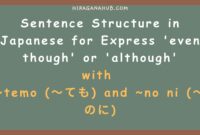Japanese Imperative Forms: ください, ちょうだい, なさい, ろ/え
Knowing how to give commands or requests is essential when
learning Japanese. Different levels of
formality and politeness determine which form to use.
This guide covers four imperative structures:
✅ ください (kudasai) – Polite requests
✅
ちょうだい (choudai) – Casual requests
✅
なさい (nasai) – Soft yet firm commands
✅
ろ/え (ro/e) – Harsh and direct commands
Before starting, ensure you understand
verb groups, te-form, and stem form (renyoukei 連用形) to
follow these structures easily.

1. Making Polite Requests with ください (kudasai)
The most common and polite way to request something is by adding
kudasai after a te-form verb. This is
frequently used in daily conversations.
Examples:
- まってください – matte kudasai: Please wait.
-
ここにかいてください – koko ni kaite kudasai:
Please write here.
If the context is clear, kudasai can be omitted:
-
わたしにはなして – watashi ni hanashite: Talk to
me.
For a more formal tone, use
お + verb stem + kudasai:
- おまちください – omachi kudasai: Please wait.
- おはいりください – ohairi kudasai: Please enter.
When requesting objects, use
を (o) + kudasai:
-
そのぺんをください – sono pen o kudasai: Please
give me that pen. -
あおいふくをください – aoi fuku o kudasai: Please
give me the blue clothes.
To request not to do something, use the
negative form + de kudasai (でください):
-
ここでたべないでください –
koko de tabenai de kudasai: Please don’t eat here.
You can also drop kudasai:
-
ここでたべないで – koko de tabenai de: Don’t eat
here.
2. Casual Requests with ちょうだい (choudai)
The choudai request works the same way as
kudasai, but it is less formal and often
used by women or children. Attach choudai to
the te-form of a verb.
Examples:
- みせてちょうだい – misete choudai: Show me.
-
ゆっくりよんでちょうだい – yukkuri yonde choudai:
Read slowly.
💡 Difference between kudasai and choudai:
- Kudasai sounds polite and neutral.
- Choudai is casual and feminine.
3. Soft Commands with なさい (nasai)
This is a gentle yet firm way to give commands, often used by
parents to children or teachers to students.
To form it, add nasai to a
verb’s stem form (renyoukei).
Examples:
-
しっかりべんきょうしなさい –
shikkari benkyou shinasai: Study hard. - おかえりなさい – okaerinasai: Welcome home.
Shortened version:
-
おかえり – okaeri: Welcome home (even more
casual).
4. Strong Commands with ろ / え (ro/e) – Harsh and Direct
This direct and rude command form is mainly used in
anime, manga, and arguments. It is rarely used in real life
unless in military settings or among close friends jokingly.
Formation:
✅ Group 1 (Godan verbs): Replace u with
e.
✅ Group 2 (Ichidan verbs): Replace
る (ru) with ろ (ro).
✅
Irregular verbs:
- する (suru) → しろ (shiro)
- くる (kuru) → こい (koi)
Examples:
- しぬ → しね – shinu → shine: Die! (very rude)
-
はなす → はなせ – hanasu → hanase: Speak!
(shouting) - たべる → たべろ – taberu → tabero: Eat!
-
しらせる → しらせろ – shiraseru → shirasero:
Inform them! - くる → こい – kuru → koi: Come here!
- べんきょうしろ – benkyou shiro: Study!
To negate this form, simply
add な (na) after the dictionary form:
- それをたべるな – sore o taberu na: Don’t eat that!
- しぬな – shinu na: Don’t die!
Comparison Table: Japanese Commands
| Type | Structure | Example | Meaning |
|---|---|---|---|
| Polite Request | Te-form + kudasai | まってください | Please wait. |
| Formal Polite | お + Verb stem + kudasai | おまちください | Please wait. (formal) |
| Casual Request | Te-form + choudai | みせてちょうだい | Show me. (casual, feminine) |
| Gentle Command | Verb stem + nasai | べんきょうしなさい | Please learn. |
| Harsh Command (Group 1) | Replace -u with -e | はなす → はなせ | Speak! (rude) |
| Harsh Command (Group 2) | Replace -ru with -ro | たべる → たべろ | Eat! (rude) |
| Harsh Command (Irregular) | する → しろ, くる → こい | くる → こい | Come! (rude) |
| Negative Command | Dictionary form + na | たべるな | Don’t eat! |
Vocabulary List
| Kanji | Hiragana | Romaji | Meaning |
|---|---|---|---|
| 待つ | まつ | matsu | To wait |
| 書く | かく | kaku | To write |
| 話す | はなす | hanasu | To speak |
| 勉強する | べんきょうする | benkyou suru | To study |
| 来る | くる | kuru | To come |
| 見せる | みせる | miseru | To show |
| 読む | よむ | yomu | To read |
| 食べる | たべる | taberu | To eat |
| 死ぬ | しぬ | shinu | To die |
| 知らせる | しらせる | shiraseru | To inform |
Final Thoughts
Now you understand how to form commands and requests in
Japanese!
💡 Use:
- Kudasai for polite requests.
- Choudai for casual, feminine speech.
- Nasai for firm but gentle commands.
-
Ro/e for aggressive or anime-style speech (use with
caution!).
If you have any questions, feel free to ask. Don’t forget to share this with
fellow learners. Happy studying!


